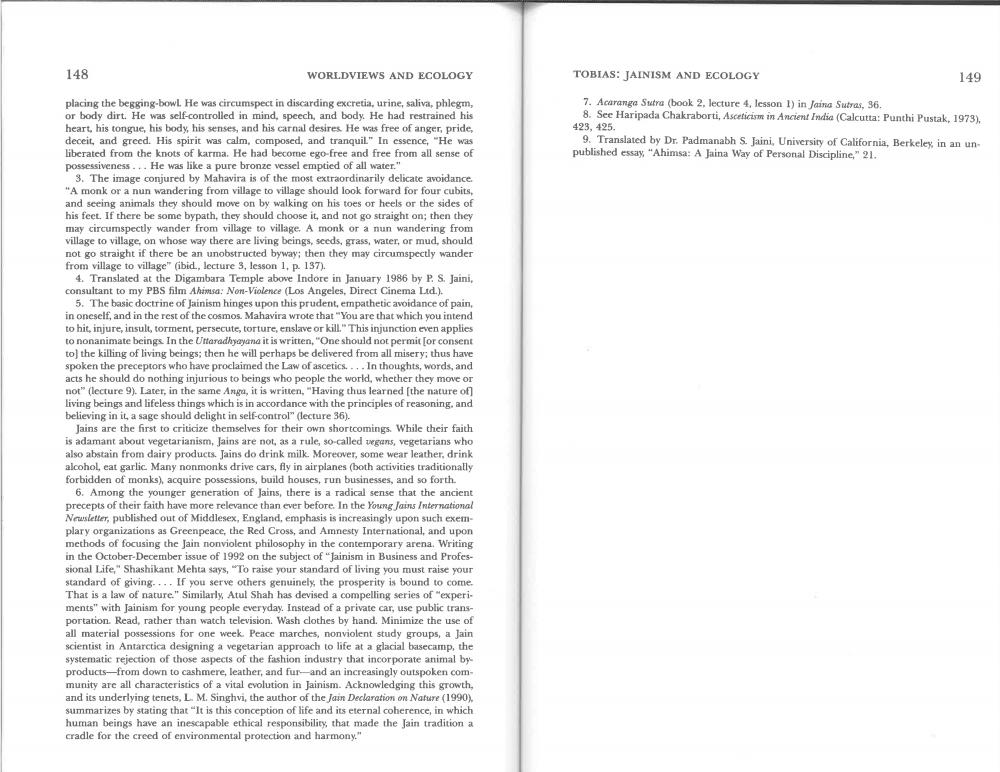Book Title: Jainism and Ecology Views of Nature Nonviolence and Vegeteranism Author(s): Michael Tobias Publisher: Michael Tobias View full book textPage 6
________________ 148 WORLDVIEWS AND ECOLOGY TOBIAS: JAINISM AND ECOLOGY 149 7. Acaranga Sutra (book 2, lecture 4, lesson 1) in Jaina Sutras, 36. 8. See Haripada Chakraborti, Asceticism in Ancient India (Calcutta: Punthi Pustak, 1973), 423, 425. 9. Translated by Dr. Padmanabh S. Jaini, University of California, Berkeley, in an unpublished essay, "Ahimsa: A Jaina Way of Personal Discipline," 21. placing the begging-bowl He was circumspect in discarding excretia, urine, saliva, phlegm, or body dirt. He was self-controlled in mind, speech, and body. He had restrained his heart, his tongue, his body, his senses, and his carnal desires. He was free of anger, pride, deceit, and greed. His spirit was calm, composed, and tranquil." In essence, "He was liberated from the knots of karma. He had become ego-free and free from all sense of possessiveness ... He was like a pure bronze vessel emptied of all water." 3. The image conjured by Mahavira is of the most extraordinarily delicate avoidance. "A monk or a nun wandering from village to village should look forward for four cubits, and seeing animals they should move on by walking on his toes or heels or the sides of his feet. If there be some bypath, they should choose it, and not go straight on; then they may circumspectly wander from village to village. A monk or a nun wandering from village to village, on whose way there are living beings, seeds, grass, water, or mud, should not go straight if there be an unobstructed byway; then they may circumspectly wander from village to village" (ibid., lecture 3, lesson 1, p. 137). 4. Translated at the Digambara Temple above Indore in January 1986 by P. S. Jaini, consultant to my PBS film Ahimsa: Non-Violence (Los Angeles, Direct Cinema Ltd.). 5. The basic doctrine of Jainism hinges upon this prudent, empathetic avoidance of pain, in oneself, and in the rest of the cosmos. Mahavira wrote that "You are that which you intend to hit, injure, insult, torment, persecute, torture, enslave or kill." This injunction even applies to nonanimate beings. In the Uttaradhyayana it is written, "One should not permit (or consent to) the killing of living beings; then he will perhaps be delivered from all misery; thus have spoken the preceptors who have proclaimed the Law of ascetics. ... In thoughts, words, and acts he should do nothing injurious to beings who people the world, whether they move or not" (lecture 9). Later, in the same Anga, it is written, "Having thus learned the nature of] living beings and lifeless things which is in accordance with the principles of reasoning, and believing in it, a sage should delight in self-control" (lecture 36). Jains are the first to criticize themselves for their own shortcomings. While their faith is adamant about vegetarianism, Jains are not, as a rule, so-called vegans, vegetarians who also abstain from dairy products. Jains do drink milk. Moreover, some wear leather, drink alcohol, eat garlic. Many nonmonks drive cars, fly in airplanes (both activities traditionally forbidden of monks), acquire possessions, build houses, run businesses, and so forth. 6. Among the younger generation of Jains, there is a radical sense that the ancient precepts of their faith have more relevance than ever before. In the Young Jains International Newsletter, published out of Middlesex, England, emphasis is increasingly upon such exemplary organizations as Greenpeace, the Red Cross, and Amnesty International, and upon methods of focusing the Jain nonviolent philosophy in the contemporary arena. Writing in the October-December issue of 1992 on the subject of "Jainism in Business and Professional Life," Shashikant Mehta says, "To raise your standard of living you must raise your standard of giving.... If you serve others genuinely, the prosperity is bound to come. That is a law of nature." Similarly, Atul Shah has devised a compelling series of "experiments" with Jainism for young people everyday. Instead of a private car, use public transportation. Read, rather than watch television. Wash clothes by hand. Minimize the use of all material possessions for one week. Peace marches, nonviolent study groups, a Jain scientist in Antarctica designing a vegetarian approach to life at a glacial basecamp, the systematic rejection of those aspects of the fashion industry that incorporate animal byproducts--from down to cashmere, leather, and fur--and an increasingly outspoken community are all characteristics of a vital evolution in Jainism. Acknowledging this growth, and its underlying tenets, L. M. Singhvi, the author of the Jain Declaration on Nature (1990), summarizes by stating that "It is this conception of life and its eternal coherence, in which human beings have an inescapable ethical responsibility, that made the Jain tradition a cradle for the creed of environmental protection and harmony."Page Navigation
1 ... 4 5 6
